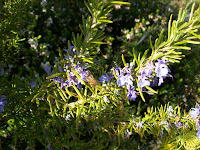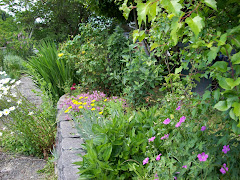Thursday, April 8, 2010
Eating Weeds and Sedums
Only sightly worried that my daughter was eating something she shouldn't, I googled "sedum edible" to see if it was. Happily, I found a September 19, 2006 Living in Season blog entry that talked about eating sedums. Apparently the ones with yellow flowers have slight toxicity until cooked, while the ones with red flowers are fine even without cooking.
One more yummy flower to eat from my yard!
Last summer I enjoyed many amazing glasses of iced tea with roses, fennel, and of course lemon balm. This spring I've managed to stave off hayfever with a small daily serving of dandelion flowers. Last month, I even got a nice helping of blanched dandelion greens with fish sauce before they got too bitter. Twice I managed to sneak some of the greens into meatloafs to benefit my less than enthusiastic family members. My kids didn't even notice.
Friday, May 8, 2009
Welcome Back Bees
 Today was the first time I've seen honey bees this year. With all the news about declining honey bee populations worldwide, I was sure glad to see them! The two bees were collecting pollen from my rosemary blooms. They didn't seem to mind me taking a few shots of them.
Today was the first time I've seen honey bees this year. With all the news about declining honey bee populations worldwide, I was sure glad to see them! The two bees were collecting pollen from my rosemary blooms. They didn't seem to mind me taking a few shots of them.After admiring the two bees that visited my yard, I decided to do some internet research about honey bees. There are a number of factors contributing to their decline. In almost every state, hives are succombing to colony collapse disorder, die-off characterized by adult bees leaving the hive. Possible causes include pesticides, parasites, and nutrition. One good site to get local information about honey bees is the Washington State Beekeepers Association.
I am not sure how much small gardeners can help, but I think keeping a variety of plants and not using pesticides is a good start.

Saturday, April 4, 2009
A New Year in the Garden
 April begins a new year in the garden. The daffodils and hyacinths have come and gone, and the tulips are in their glory. This week our phlox erupted in beautiful purple flowers, and the first blossoms emerged on our dwarf Fuji apple tree. The Olympia Farmers Market has opened, and I have already purchased a wonderful new plant there, a Kinkaku Japanese tree peony from the Lilly Pad. It is only a one-year graft so I should have fun watching it develop over the next couple years.
April begins a new year in the garden. The daffodils and hyacinths have come and gone, and the tulips are in their glory. This week our phlox erupted in beautiful purple flowers, and the first blossoms emerged on our dwarf Fuji apple tree. The Olympia Farmers Market has opened, and I have already purchased a wonderful new plant there, a Kinkaku Japanese tree peony from the Lilly Pad. It is only a one-year graft so I should have fun watching it develop over the next couple years.Our prolific neighborhood weeds have also emerged. Rather than hoeing and pulling, I am using the spaghetti garden method of smothering them with old paper grocery bags, newspaper, and bark.
 This doesn't completely eliminate traditional weeding, but it cuts down on it considerably. Over time this method should improve the overall soil quality by adding organic matter instead of taking it away. I am a little concerned about pH levels as all of these materials are acidic. I am planning to add lime as a counterbalance, but, if anyone has any better ideas, please feel free to share them.
This doesn't completely eliminate traditional weeding, but it cuts down on it considerably. Over time this method should improve the overall soil quality by adding organic matter instead of taking it away. I am a little concerned about pH levels as all of these materials are acidic. I am planning to add lime as a counterbalance, but, if anyone has any better ideas, please feel free to share them.In addition to normal maintenance, I have a number of tasks I would like to accomplish this season:
- Plant potatoes, lettuce and other vegetables in our back garden beds, and plant kale for overwintering later in the season.
- Create new stepping stones (No one seems to sell the type I have anymore. I could only find those fake plastic composite ones or the fancy $30+ stones that are better suited for display than for stepping on.)
- Install a drip irrigation system (This should save both time and money in the long run. I have already begun purchasing supplies, but, with full time work and graduate school, I don't expect to get going on this project until after June.)
- Create a minature portable fountain that can be easily moved and stored when not in use.
- Attend more garden swaps and connect with local gardeners
- Explore more Olympia parks and trails with my family.
I recently finished my first big task this season. My entry from the sidewalk to the road consisted of a row of flat concrete rectangles leading up to a muddy ditch. Not only did it look terrible, but the rectangles were always sliding down into the ditch, and we were always tracking mud into our car and house. I used pit run from Great Western Supply to create the new path and fill up the ditch. Not only is this material cheap, but it settles nicely into the ditch and blends with the old sidewalk and walkway leading up to it. Instead of sticking with a straight row, I created a widening path whose contours mimic the walks in our yard. The contours also conform to the actual paths in the grass that my family used to get to the car. My philosophy has always been to follow the wear lines when creating a path. Not only is the path pleasing to the eye, but it is far more functional. We can get to both doors and the tr unk and can walk around our car to the road without leaving the path. The path is lined with terracota edging I already had and is surrounded on both sides by fir bark (also from Great Western). The bark extends around our blueberries and dwarf apple trees and then slopes away to create two sort of half circles on either side. I used cedar edging I already had to keep the bark off the sidewalk, and those concrete rectangles and the bigger stones in the pit run were put to good use keeping the bark contained on the other side. I plan to get some landscaping edging that we can mow right over to keep the adjoining grass from invading into the bark.
unk and can walk around our car to the road without leaving the path. The path is lined with terracota edging I already had and is surrounded on both sides by fir bark (also from Great Western). The bark extends around our blueberries and dwarf apple trees and then slopes away to create two sort of half circles on either side. I used cedar edging I already had to keep the bark off the sidewalk, and those concrete rectangles and the bigger stones in the pit run were put to good use keeping the bark contained on the other side. I plan to get some landscaping edging that we can mow right over to keep the adjoining grass from invading into the bark.
Monday, July 14, 2008
Twelve Roses and Two Weeks Away

Monday, July 7, 2008
Growing Potatoes
His point, of course, was to show how much more attuned we are with corporate images than with the actual food that sustains us. For myself, I recognized the broccoli and the apple tree, but not the potato. The sad irony here is that my great-grandparents were Irish farmers who were forced to leave Ireland during the Potato Famine, and their great-granddaughter couldn't even recognize the crop that so profoundly impacted their lives.
In tribute to my heritage (and because I had some potatoes in my pantry that started growing eyes), I am growing potatoes for the first time in my raised bed vegetable garden. My daughter, Thalia, is also growing potatoes in a little pot in the front yard. At this point, all of the potatoes are doing well, but my daughter's are about twice the size of mine. (Due perhaps to the better potting soil in her pot?)
Below are pictures of both her potato plants and mine. The broadleafed plants by them are a mystery squash that came up in my not-quite-fully-cooked compost.


Sunday, June 29, 2008
The Joys of Free
 After three years of waiting, my hydrangea has finally bloomed! Currently I have over seven blooms. Not surprisingly with my acidic soil, my blooms are a stunning deep blue.
After three years of waiting, my hydrangea has finally bloomed! Currently I have over seven blooms. Not surprisingly with my acidic soil, my blooms are a stunning deep blue.I got my hydrangea for free in a plant swap at the East Side Community Garden. This picture features several plants, the hydragea, daylilies, daisies, irises(not blooming) and the extremely prolific mystery plant in front of the daylilies, that came from that swap.
 Not only do I enjoy free plants, but I have the pleasure of meeting other Olympia gardeners and watching their plants thrive in my garden.
Not only do I enjoy free plants, but I have the pleasure of meeting other Olympia gardeners and watching their plants thrive in my garden.Sunday, June 22, 2008
Summer Walks and Roses



 Following the shady winding paths and relaxing by gently trickling streams provide the perfect end to a day of gardening. My daughter, Thalia, collected many little treasures along the way.
Following the shady winding paths and relaxing by gently trickling streams provide the perfect end to a day of gardening. My daughter, Thalia, collected many little treasures along the way. My Front Yard Plants
- Autumn Joy Sedum
- Azalea
- Basket of Gold
- Bearded Iris
- Black Eyed Susan (Rudbeckia Fulgida)
- Blueberry
- Boxwood
- Bridal Veil Bush
- Burning Bush
- Candytuft (Iberis Sempervirens)
- Carnations
- Cat Mint
- Chysanthemum
- Daffodils
- Dahlia
- Daylillies
- Dogwood Tree (It's still very tiny.)
- Euonymus
- Fennel
- Fuji Apple Tree
- Garlic
- Golden Rain Tree
- Hardy Geranium
- Heather
- Hen and Chicks
- Honeycrisp Apple Tree
- Huechera
- Hyacinth
- Hydrangea
- Ice Plant
- Jackmanii Clematis
- Kinkaku Japanese Tree Peony
- Kinnikinnick
- Lady's Mantle
- Laurel Bush
- Lavender
- Lemon Balm
- Lithodora
- Love in the Mist
- Marshmallow
- Oregano
- Oregon Stonecrop Sedum
- Osteospernum
- Phlox
- Primrose
- Purple Sage
- Rose
- Rosemary
- Sedum Cockerellii
- Sedum Hispanicum
- Sedum ternatum 'Larinem Park'
- Shasta Daisy
- Sorrell
- Strawberries (Everbearing)
- Tulips
- Unknown Plants
- Vinca
- Winter Savory
- Wooly Thyme
- Yarrow




